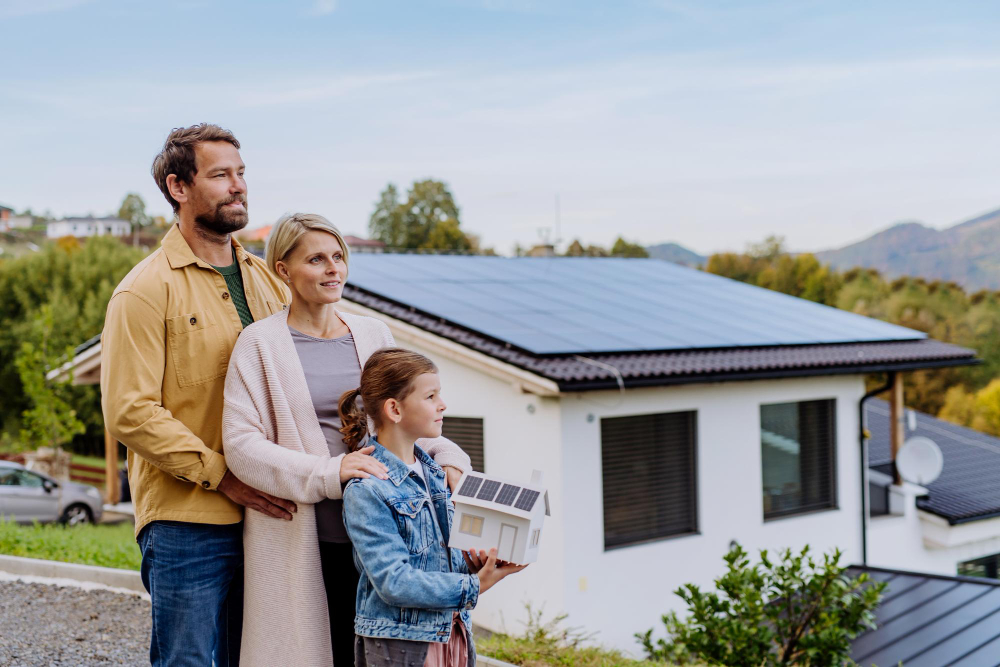
Switching to solar energy for your home isn’t just about saving money—it’s about choosing a cleaner, more sustainable lifestyle. With electricity prices rising across India, more homeowners are turning to solar as a reliable, cost-effective, and eco-friendly solution.
In this guide, we’ll break down everything you need to know about solar power for homes: how it works, costs, government subsidies, and whether it’s the right choice for your family.
What is Solar Energy for Your Home?
Solar energy for your home refers to using solar panels to capture sunlight and convert it into usable electricity. These panels, usually installed on rooftops, generate power through photovoltaic (PV) cells. The electricity can then run your appliances, lights, and even air conditioners.
If your system is grid-tied, extra power you produce can be sent back to the grid through net metering, reducing your electricity bills even further. Off-grid systems, on the other hand, store energy in batteries and are perfect for remote locations.
Why More Indians Are Choosing Solar
- High electricity bills – Solar cuts monthly costs by 70–90%.
- Government subsidies – Schemes like PM Surya Ghar Yojana make it affordable.
- Eco-conscious living – Reduces carbon footprint.
- Long-term investment – Panels last 20–25 years, giving reliable power.
- Energy independence – Less reliance on power cuts or fluctuating tariffs.
How Solar Energy for Homes Works
- Solar Panels: Installed on your roof to capture sunlight.
- Inverter: Converts Direct Current (DC) into Alternating Current (AC), which your home appliances use.
- Metering: Net meters track how much power you use vs send back to the grid.
- Battery (optional): Stores excess power for backup in off-grid or hybrid systems.
This is essentially the same technology powering large solar electricity for homes projects across India.
Types of Solar Systems for Homes
When you consider Solar Power Panels for Home, you’ll likely choose between three system types:
- On-grid: Most popular and affordable, connected to the utility grid.
- Off-grid: Independent, requires batteries.
- Hybrid: Mix of both, with storage and grid support.
Cost of Solar Energy for Homes in India
The Solar Panels and Cost factor is one of the biggest considerations. Here’s a simple breakdown (approximate 2025 pricing):
- 1kW system: ₹75,000 – ₹85,000 (suitable for a small home, runs lights/fans)
- 3kW system: ₹1,50,000 – ₹1,70,000 (ideal for a family home, runs AC, TV, fridge)
- 5kW system: ₹2,50,000 – ₹3,00,000 (larger homes with high consumption)
With subsidies, prices can drop by 30–40%, making solar affordable for middle-class families.
Subsidies & Government Incentives (2025)
Under PM Surya Ghar Yojana:
- 2kW rooftop system: Up to ₹60,000 subsidy
- 3kW rooftop system: Up to ₹78,000 subsidy
- Beyond 3kW: Fixed subsidy for eligible households
This makes solar energy for your home much more accessible, especially in urban and semi-urban India.
Installation Process – What to Expect
Hiring the right Solar Energy Contractors makes all the difference. The typical process is:
- Site survey – Evaluate your roof type, orientation, and shading.
- System design – Based on your energy needs.
- Subsidy application – Contractors help file with DISCOM.
- Installation – Mounting panels, wiring, inverter setup.
- Grid connection & net meter – For on-grid systems.
How Solar Energy Adds Value to Your Home
Just like Solar Power to House discussions highlight, solar isn’t just about saving money—it increases property value. Homes with solar panels sell faster and at better prices because buyers see them as future-proof.
Maintenance and Lifespan
One of the best parts of solar is that it requires minimal maintenance:
- Cleaning panels every 15–30 days
- Occasional inspection of wires and inverter
- Monitoring via mobile apps
Most panels come with 25-year warranties, making them a worry-free investment.
Premium solutions like sunpower solar panels are also gaining popularity for their high efficiency.
FAQs
Q1: How many solar panels are required for a 2BHK house?
A: Typically, a 2–3kW system (6–9 panels) is enough for average use.
Q2: Do solar panels work during cloudy days?
A: Yes, though efficiency drops slightly. Hybrid systems with batteries are ideal in such conditions.
Q3: What’s the payback period of a home solar system?
A: Usually 4–6 years, after which savings are essentially free electricity.
Q4: Can I run heavy appliances on solar?
A: Yes, with the right system size, solar can run ACs, washing machines, and refrigerators.
Q5: Do I need special permission to install solar?
A: For on-grid systems, approvals are needed from DISCOM, which contractors handle for you.
Q6: How long does installation take?
A: Most residential projects are completed within 5–7 days.
Q7: Can solar panels be moved if I change houses?
A: Yes, they can be dismantled and reinstalled, though some cost will apply.
Q8: Are batteries compulsory for home solar systems?
A: No, only off-grid or hybrid systems need batteries. On-grid systems don’t.
Q9: Is solar energy for homes safe?
A: Absolutely. Panels are tested for safety, and inverters regulate current.
Q10: Will solar energy lower my carbon footprint?
A: Yes, significantly. A 5kW system offsets around 6–7 tons of CO2 annually.
Final Thoughts
Switching to solar energy for your home is one of the smartest financial and environmental decisions you can make in 2025. It lowers your electricity bills, increases your property value, and reduces dependency on the grid—all while helping fight climate change.
With falling panel prices, government subsidies, and reliable Solar Energy Contractors, there’s never been a better time to go solar.
